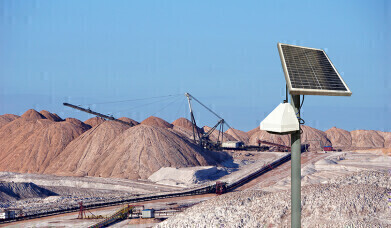Air Monitoring
What is in the air leaving your sites?
Mar 15 2023
Why would you want to know and what could you do about it anyway? Many processes in the petrochemical, refining, gas and oil industries cause known or unknown emissions of gases and particles into the air. Whether the reason is legislation, the company’s Environmental Social and Governance (ESG) policy, to protect sensitive neighbours, such as schools and communities, or to just understand what is in the air at a site boundary, real-time, continuous monitoring makes sense.
Small sensors with standalone power and communications offer a convenient and cost-effective solution. Measurement nodes or ‘pods’ can be easily installed on fences, posts or walls around the site and its perimeter, streaming accurate data securely to the cloud and the client’s database, and triggering alerts.
Exceedance alerts can be set at a level and frequency to suit the application, potentially triggering a bag sample to be taken, for more detailed air composition analysis. This type of monitoring also allows operators to assess a wide range of pollutant levels across space and time. A time-series plot of multiple measurements, including NOx, SOx, CO2, CO, TVOC, CH4, H2S and particulate matter can be reviewed against known site operations and events. “We find that as soon as operators start to see the readings coming in, are able to track peaks of pollutants and relate them to operations and events, they are hooked, and can see exactly how they can use this information”, comments AQMesh CEO, Amanda Billingsley.
Continuous readings at 15-minute intervals – or even 1-minute – can provide a more complete emissions picture than intermittent bag samples or even open-path monitoring, particularly when combined with wind speed and direction information. A single AQMesh pod can measure over 10 pollutants at the same time, plus wind speed and direction, temperature, atmospheric pressure and RH%. These confidential readings are all made available on the same secure platform, accessible either by login, or by API.
There is a major trend towards industrial operators including oil and gas, petrochemicals, construction, mining and transport – rail and ports, as well as roads – wanting to look closely at air pollution on and around their sites.
Analysis of air pollution measurements, used with wind speed and direction information, and potentially modelling, can help identify pollution sources (which direction and how far away) as well as which pollution is generated locally (directly manageable) and which is more regional (requires more collaboration). This means an operator can distinguish between pollution generated by their operations or that of a neighbouring plant. Multi-parameter monitoring systems, such as AQMesh, use the mobile phone network and can be solar-powered, meaning they need no infrastructure investment. It is literally a 10-minute job to attach the pod to a post and start to see readings online. Each pod can take many measurements, including NO2, SO2, H2S, CO2, CO, TVOC, CH4, PM1, PM2.5, PM4, PM10, total particle count, PM Total, O3, NO, temperature, pressure and RH% and can be used as a network, with smart, remote calibration.
Multi-parameter monitoring systems, such as AQMesh, use the mobile phone network and can be solar powered, meaning they need no infrastructure investment. It is literally a 10-minute job to attach the pod to a post and start to see readings online. Each pod can take many measurements, including NO2, SO2, H2S, CO2, CO, TVOC, CH4, PM1, PM2.5, PM4, PM10, total particle count, PM Total, O3, NO, temperature, pressure and RH% and can be used as a network, with smart, remote calibration.
Small, micro or low-cost sensors can offer a cost-effective solution for industrial boundary monitoring, with a range of benefits: real-time understanding of air pollution changes around a site perimeter means fast action can be taken. Geographically pinpointed, regular air composition readings can feed into feasibility or environmental impact studies. AQMesh has been used by industrial operators across continents, with direct, worldwide support from the manufacturer.
Complementing ongoing stationary monitoring, the hand-held Gazoscan used a sensitive and accurate laser sensor to scan for methane, across a distance of up to 100m. The portable laser Inspectra samples from a local point and can detect, measure and store methane readings from around a site. Integrated software allows secure, traceable readings to be logged directly against a geographic and/or named infrastructure point, with photos and notes.
Digital Edition
AET 28.2 April/May 2024
May 2024
Business News - Teledyne Marine expands with the acquisition of Valeport - Signal partners with gas analysis experts in Korea Air Monitoring - Continuous Fine Particulate Emission Monitor...
View all digital editions
Events
Jul 30 2024 Jakarta, Indonesia
China Energy Summit & Exhibition
Jul 31 2024 Beijing, China
2024 Beijing International Coal & Mining Exhibition
Aug 07 2024 Beijing, China
IWA World Water Congress & Exhibition
Aug 11 2024 Toronto, Canada
Aug 25 2024 Stockholm, Sweden and online









.jpg)








